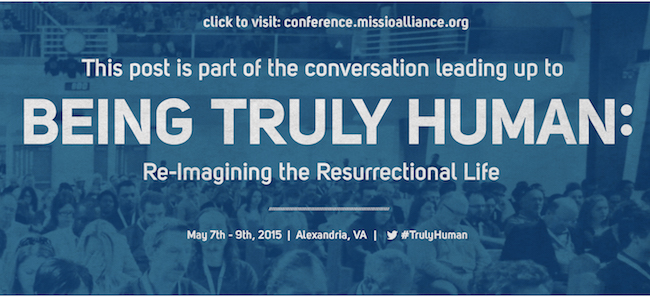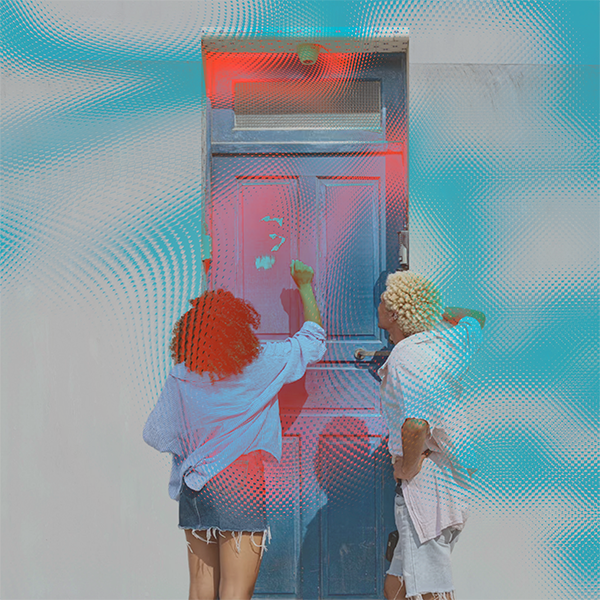Being #TrulyHuman in Protest: The Icon of the Trinity
“The glory that you have given me I have given them, so that they may be one, as we are one.” – John 17:22
In the life-creating nature of the Father, Son, and Holy Spirit there is no division, but only a continuous and inseparable communion (koinonia) between them …It is not possible to envisage any severance or division…but there is between them an ineffable and inconceivable communion (koinonia) and distinction. – St. Gregory of Nyssa [1]
What did Jesus mean when he prayed that they (the Church) may be one, as we (Father, Son and Spirit) are one?
Dare we tread into the paradoxical “Three-in-One and One-in-Three” waters as we explore the question of what it means to be #TrulyHuman?
Dropping the word perichoresis into a theological conversation or sermon will give you instant seminary cred! It is a Greek word derived from the verb chorein which means ‘to make room or space’ and with the suffix peri adds a sense of encircling and surrounding (the same root is present in the english word ‘perimeter’). Perichoresis, although not in Scripture, became a key word for how the Church understood how Christ was both fully divine and fully human. Later, it became an even more useful metaphor for describing the inseparability of Persons without loss of each Person’s identity contained within the Trinity – the Father, Son, and Spirit – mutually making room for one another around each other. Perichoresis describes God as communion.
If God is communion, and humans are made in the image, or icon, of God, then what kind of communion is possible (or called for) for the #TrulyHuman ones?
Miroslav Volf warns us from making a strict correspondence between the interiority of the divine to the relating that happens between humans. Volf notes that Jesus does not pray that the Church may be in one another.[2] An icon of God is not God. An icon points to something or someone beyond itself. An icon is an open window that directs our eyes out beyond. Through the icon we see the way forward toward the Divine. The Church as an Icon may not experience perichoretic relating within itself, but it still is called to bear witness, through relationships of love and unity, to a God who does.
Greek Orthodox theologian, Kallistos Ware, argues from John 17:21-23, that “we humans, icons of the Trinity, are called to figure forth on earth the movement of God’s perichoresis, reproducing here below the mutual love that passes unceasingly in heaven between Father, Son, and Holy Spirit. This trinitarian even as is vital for our salvation.” The act of separating ourselves from one another and refusing to be our brother’s keeper is to mar the icon of the Trinity.
In light of what’s going on with the #BaltimoreUprising and #BlackLivesMatter it seems appropriate to return to and finish our conversation on Protest as Sacrament. Each week when we consecrate the bread and wine at the Eucharist, we invoke God to send God’s Spirit on this meal so in our eating and drinking by faith, we are invited to share communion with God and with one another. We are invited to have our #TrulyHuman-ness renewed in Christ. In the eating and the drinking we are renewing our commitment to be our sister’s and brother’s keeper so that God may be glorified.
The idea of perichoresis is central to our unity and embracing one another as #TrulyHuman. Perichoresis provides a model to live out the sacrament of communion together. We cannot take communion together and remain indifferent to one another.
We previously spoke to how protest can become a space of solidarity- allowing ourselves to embody the hurt, identity and experience of another. The perichoretic model of interdependence shows a beautiful humility. It recognizes the fullness of God as interdependence.
Freddie Gray. Eric Garner. Tamir Rice. Trayvon Martin. #Black Lives Matter because they are the image of God. These names, these events, these riots and protesting should be driving us to find the image of God in these people. Why are these lives being taken? Why are we missing the image of God in black men? We need to recognize that hurting black lives also hurts the image of God in us.
As we bear witness to Christ in each other, we recognize that when one of us hurts, all of us hurt. I cannot be Truly Human unless the image of God in YOU is honored. When Jesus prayed that we would become one, he was pointing to a shared identity in the Father. Perichoresis models this identity – it is the way we can experience each other fully, as a reflection of God. As we pursue unity we experience more of who God is by honoring the Imago Dei in others. It is a model of true reconciliation — may I understand who Christ is in you, so I may understand God more. God did not reconcile us to himself so we would lose our identity, but rather so we may live out a deeper reflection of who we are in Him.
Our images, our identities are an expression of his glory.
[1] On the Difference between Essence and Hypostasis Basil, Letter 381, §4
[2] Volf, Miroslav. After Our Likeness: The Church as the Image of the Trinity. 210-211.
[3] Ware, Kallistos. “The Human Person as Icon of the Trinity.” Sobornost 8, no. 2 (1986) 6-23.
[Photo: Painting of a feast / Early Christian catacomb of San Callisto (Saint Calixte Catacomb) / 3rd century / Paleochristian art. http://muvtor.btk.




